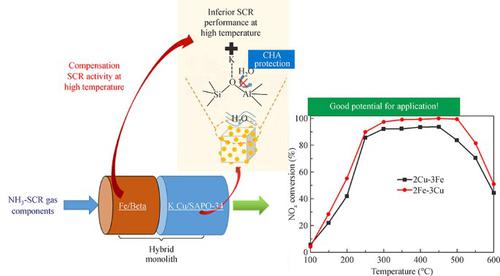Frontiers of Environmental Science & Engineering ( IF 6.4 ) Pub Date : 2020-09-09 , DOI: 10.1007/s11783-020-1322-1 Chen Wang , Jun Wang , Jianqiang Wang , Meiqing Shen

|
Kions were introduced onto Cu/SAPO-34 catalysts via the ion-exchange process in order to improve their stability under low-temperature hydrothermal aging. The changes in structure and copper-species contents of these catalysts upon hydrothermal aging were probed in order to investigate their effects on selective catalytic reduction (SCR) activity. For the fresh Cu/SAPO-34 catalysts, K ions had little influence on the chabazite framework but effected their acidities by exchanging with acid sites. After hydrothermal aging, the structural integrity and amount of active sites decreased on pure Cu/SAPO-34. While the K-loaded catalysts showed improved chabazite structure, acidity, and active site conservation with increasing K loading. However, although the 0.7 wt% K catalyst maintained the same crystallinity, active site abundance, and low-temperature SCR activity as the fresh catalyst upon aging, an apparent decrease in SCR activity at high temperature was observed because of the inevitable decrease in the number of Brönsted acid sites. To compensate for the activity disadvantage of K-loaded Cu/SAPO-34 at high temperature, Fe/Beta catalysts were co-employed with K-loaded Cu/SAPO-34, and a wide active temperature window of SCR activity was obtained. Thus, our study reveals that a combined system comprising Fe/Beta and K-loaded Cu/SAPO-34 catalysts shows promise for the elimination of NOx in real-world applications.
中文翻译:

离子交换钾对Cu / SAPO-34低温水热稳定性的促进作用及其与Fe / Beta催化剂的协同应用
通过离子交换工艺将钾离子引入Cu / SAPO-34催化剂中,以提高其在低温水热老化下的稳定性。为了研究它们对选择性催化还原(SCR)活性的影响,探讨了这些催化剂在水热老化后的结构和铜种类的变化。对于新鲜的Cu / SAPO-34催化剂,K离子对菱沸石骨架几乎没有影响,但通过与酸位交换来影响其酸度。水热老化后,纯Cu / SAPO-34的结构完整性和活性位点数量下降。负载钾的催化剂显示出菱沸石的结构,酸度和活性位点随钾负载的增加而改善。但是,尽管0.7 wt%的K催化剂保持了相同的结晶度,但活性位点的丰度仍然很高,并且作为老化后的新鲜催化剂的低温SCR活性,由于布朗斯台德酸位的数量不可避免地减少,因此观察到高温下SCR活性明显降低。为了弥补K负载的Cu / SAPO-34在高温下的活性缺点,Fe / Beta催化剂与K负载的Cu / SAPO-34共同使用,获得了SCR活性的宽活性温度窗口。因此,我们的研究表明,由Fe / Beta和负载K的Cu / SAPO-34催化剂组成的组合系统有望消除NO。Fe / Beta催化剂与负载K的Cu / SAPO-34共同使用,获得了SCR活性的宽活性温度窗口。因此,我们的研究表明,由Fe / Beta和负载K的Cu / SAPO-34催化剂组成的组合系统有望消除NO。Fe / Beta催化剂与负载K的Cu / SAPO-34共同使用,获得了SCR活性的宽活性温度窗口。因此,我们的研究表明,由Fe / Beta和负载K的Cu / SAPO-34催化剂组成的组合系统有望消除NO。x在实际应用中。



























 京公网安备 11010802027423号
京公网安备 11010802027423号